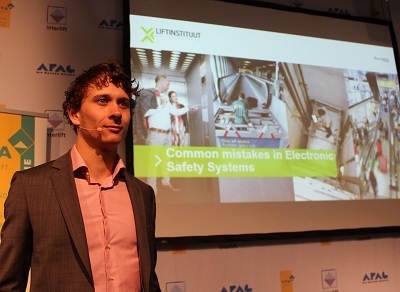It wasn’t just the trade fair, but also the VFA Forum that attracted more visitors during Interlift 2017. Liftinstituut was represented on the exhibition floor and also gave a talk during the VFA Forum. Tijmen Molema gave a talk about developments in the field of programmable electronic safety, as well as the advantages and pitfalls. Read the summary of the talk by Tijmen Molema.
 Starting with Electronic Safety Systems
Starting with Electronic Safety Systems
By: Tijmen Molema, PESS specialist Liftinstituut
Since the introduction of PESS (Programmable Electronic Safety Systems), a lot inside the elevator business has changed. There are a lot of opportunities and advantages of modern electronics. In this short paper, we would like to tell a little bit more about PESS and point out some important points for starting projects.
The modern elevator
PESS stands for Programmable Electronic Safety Systems. It basically means that electronic components or/and software make the safety decisions. There are some big advantages of PESS when compared to traditional mechanical systems. PES systems are lighter, faster, cheaper, updateable, flexible, and can even be safer. For instance: a PESS overspeed detection system can have the same hardware for different speeds, can also react on excessive acceleration, and weighs way less than a mechanical overspeed detection device.
Due to these advantages, PESS is widely used in all kinds of markets. For example, it makes self-driving cars possible, controls nuclear power plants, and also helps medical equipment to stay safe. All these technologies were impossible if only mechanical safety devices were allowed. Since the systems proved themselves to be safe, the elevator industry also became interested. Presently, there are several PESS systems in the market and the distribution between mechanical and electronical systems is changing rapidly in favour of the electronic systems.
Troubles in Paradise
However, new systems give, besides new opportunities, also new problems. And, as always, the same faults are made by companies who start with PESS. These are not only beginner’s faults, these are also cultural faults concerning elevators. The elevator business has a long history of safety and is quite conservative, and the choices that are made aim to increase safety. But with new technologies the old rules do not apply anymore and conservative decisions can actually increase rather than decrease the fault risks of a PESS system. In fact, if there is no knowledge or experience with PESS, paradise can rapidly change into hell…
Options, options, options…
When a company decides to start with PESS, all options are open. It is possible to put multiple safety functions inside one PESS system. For example, if the position and speed are known by the safety system, then the following functions can easily be created:
- Overspeed detection
- Final limit switch function
- Activation of safety gear
- UCMP
This mainly comes about because software is ultimate flexible. In a timescale of minutes, functions can be turned on/off, or overspeed values can be changed. In a timescale of days, new functions can be created. However, the endless possibilities also introduce some risk. For example, where and how do you keep to the scope of the project? When the scope of a project fails, timelines, budgets and feasibility come under pressure. A clear project goal and scope supported by documentation and a fair timeline asks for experience. Notified Bodies (NoBo’s) can support to reach these goals.
Documentation
The essential need of documentation is something that pops up at the end of a project. Usually the value is not seen directly (after all, we are engineers, not public servants!). Due to this, a variety of problems can occur: requirements will be forgotten, or are not tracked throughout the project. The project then ends up with a system which does not meet expectations and/or which is not safe. The only way to tackle this problem is by keeping proper documentation.
Other
Since PESS is a whole new design strategy, there are other standards involved. The EN-81 series take their information out of the IEC-61508. This standard is huge and places demands on calculations, design analyses, reviews, and lifecycle plans. For most of the elevator manufacturers this is a whole new world posing a lot of questions. But since it is mandatory to prove your competence, courses and a place for answering questions are probably your first steps.
Conclusion
There is a rising trend for PESS products in the market. More and more companies are willing to invest and develop electronic safety to get all the advantages. But as always with new systems and techniques come new responsibilities. Knowledge about PESS and the underlying standard is of major importance, as well as working together with a Notified Body which is up to date with the latest EN 81-20 developments. Finally, documentation should be the backbone of your product: without is not an option anymore. We strongly believe that the future is in PESS, and when done properly, the elevator industry can, and will, reach an even higher level of safety than today.




